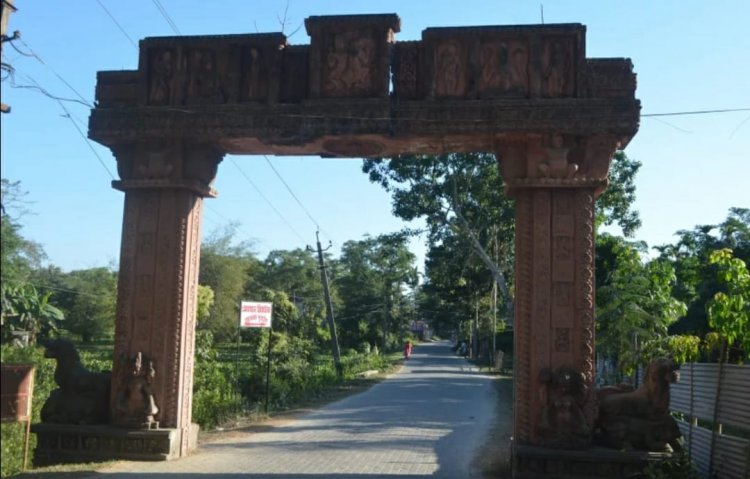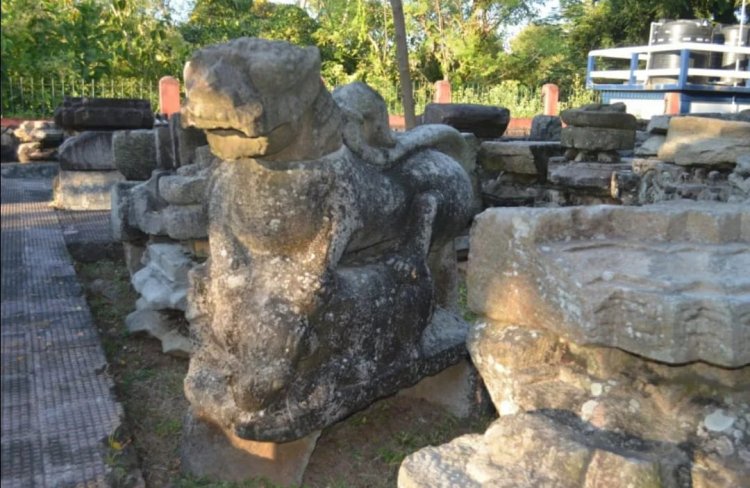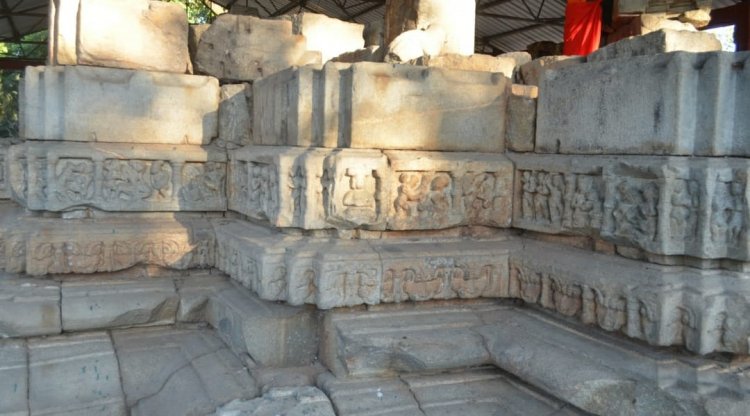Khajuraho of Assam, A Historical Enigma located on the outskirts of Guwahati.
Located in Baihata Chariali, about 40 km from Guwahati, the Madan Kamdev temple complex marks a silent but vibrant period in Assam’s ancient history.

- By, Vedatrayee Chakraborty
Kamdev, or Madan is the Hindu God of Love, and according to folklore, he had incurred the wrath of Lord Shiva for disturbing his tapas and was turned to ashes. But on the advice of his wife, Parvati, Lord Shiva restored Kamdev to his original form. The site where Kamdev regained his original form came to be known as Kamarupa. Kamdev reunited with his wife Rati, on a hillock (Dewangiri Hillock) , where he built a temple to Lord Shiva. Today, it’s known as the Madan Kamdev Temple, aka the ‘ Khajuraho of Assam ‘ .

The Madan Kamdev Temple , steeped with startling carvings of danacing nymphs and fairies, gods and goddesses, demons and griffins, serpents, animals , flowers, and men and women, dictated by a huge amount of erotic iconography, is the forebearer of the monicker “ Khajuraho of Assam “. Further, accentuating its erotic nature is the ruined garbhagriha (sanctum sanctorum) of a medieval temple. It also houses a large sculpture of Shiva and Parvati in an intimate embrace or ‘alingan' posture.
Among the ruins are also broken parts of huge pillars covered with flowers and cosmic figures; a six-headed Bhairava; a four-headed Shiva; and statues of the Sun, Ganesha and Vidyadhara, the latter celestial beings who are believed to possess great wisdom.
The area is quiet and secluded, accentuating its air of mystery and the enigma that continues to surround this archaeological treasure. No one knows for sure who built this massive temple complex, which was properly uncovered as recently as the 1970s. Excavations at the site reveal the ruins of at least 24 temples, large and small, all of which were covered in dense foliage for centuries.
Located in Baihata Chariali, about 40 km from Guwahati, the Madan Kamdev temple complex marks a silent but vibrant period in Assam’s ancient history. Historians date the temple complex to the reign of the Palas of Assam, between the 10th and 12th centuries CE. While the Palas of Bengal are well known, the Palas of Kamarupa (as Assam was then known) are one of the many ancient and medieval dynasties of North East India about whom we know little.

Noted Assamese historian K L Barua, in his book Early History of Assam, has written extensively about this little-known dynasty. Apparently, the Kingdom of Kamarupa, once the empire of the great ruler Bhaskarvarman, fell to the Mlechha dynasty between 655 CE and 900 CE. The last ruler of this dynasty was Tyaga Sinha (890-900 CE), who died without an heir. The nobles, fearing anarchy in the kingdom, elected an adventurer named Brahmapala (r. 900-920 CE) as their ruler and thus established the rule of the Palas of Kamarupa.
While the Palas of Bengal patronized Buddhist establishments, the Palas of Kamarupa were patrons of Hinduism. From their capital, Pragjyotishpur (modern-day Guwahati), they presided over a prosperous kingdom, rich in trade and commerce, and Pandit Vidyavinod, a court poet of King Ratnapala (r. 920-960 CE), wrote about how the king ‘delights in making his copper mines lucrative’.
K L Barua has written about how the Palas of Kamarupa were followers of Hindu Tantricism and built a large number of temples in Assam. It was during their rule that the famous Kamakhya temple near Guwahati gained prominence. Also, Kalika Purana, one of the most important texts in Hindu Tantric worship, was composed during the reign of the Palas. Tantric rituals involved a number of erotic practices, which are reflected in the Madan Kamdev temple complex and explain the erotic nature of its sculptures. The Pala dynasty of Kamarupa came to an end in 1100 CE, when the Palas of Bengal defeated its last ruler, Jayapala, and incorporated the kingdom into Bengal.
Incidentally, the ancient name of Assam, ‘Kamarupa’ is derived from ‘Kamdev’, and is the ‘land where the God of Love regained his original ‘form’ or ‘rupa’. It was with the advent of the Ahoms into the Brahmaputra valley in the 13th century, that the region came to be known as ‘Assam’ , after the word ‘Asama’ or ‘Invincible’ as its rulers were known. The Ahoms ruled the region right till the advent of the British in the 19th century.
Over the centuries, the Madan Kamdev temple complex was swallowed by thick forests and fell to ruin. Although no one knows when or how they fell apart, these temples were probably destroyed by one of the numerous earthquakes in this seismic-prone region. While locals have always been aware of these ruins, they came to the notice of the world at large only in the late 19th century.

With the advent of the British in Assam in 1826, large number of British army officers were posted across the valley to conduct surveys. The earliest reference to the Madan Kamdev remains is by one such British army officer, Captain Edward Tuite Dalton, an administrator with the East India Company, who had been posted in Assam in 1855, . Dalton had mentioned these ruins not far from the Silsako bridge, a historical stone bridge which collapsed during the earthquake of 1897. The site was near Changsari, 26 km from Guwahati.
Over the years, many excavations have been conducted to unearth the mystery of this beautiful temple. As the algae and thick vegetation was cleared from the walls and surrounding area, and as the debris was cleared off the rocks and stone structure, the dominance of Saivite sculptures proved that it was a centre of worship of Lord Shiva. The erotic assortment of sculptures found here included both celestial beings as well as various animals. Also, two lintels of excellent carvings and two door-sills with ‘Kalpavriksha’ (tree of plenty) sculpted on them were found.
Madan Kamdev is a fascinating open-air museum. In many places, the temple ruins are neatly stacked with a paved walkway to help visitors explore and examine the carvings and architectural details but the majority of the ruins are strewn across the site. There is also a museum that displays artefacts uncovered from the hillside.
Historians are no closer to conclusively proving who built the Madan Kamdev temple complex and why it was constructed. But it is worth visiting the site to get a feel of one of the mysteries of North East India.
What's Your Reaction?































































































































